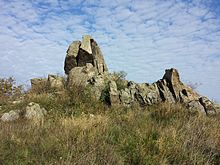Diendorf disorder
The Diendorfer Fault is a striking geological fault in the easternmost part of the Bohemian Massif . It crosses Lower Austria and South Bohemia and is the most important fault line in the region, followed by the Vitiser fault .
The fault line begins in south-western Lower Austria near Wieselburg and extends around 200 kilometers via Melk and Gansbach across the Dunkelsteinerwald and via Mautern and Langenlois to the eponymous Diendorf , where the highest longitudinal stretch is reached at almost 6 kilometers, and then over the striking terrain at Maissau via Platt , Zellerndorf and Retz on to Moravia to the Boskovice furrow . The Danube flows between Hundsheim and Krems in the geologically weakened area of the fault.
The disturbance started during the lower Permian and is due to a block of the earth's crust pushing from south to north. The disturbance can be proven petrographically through the appearance of mylonites - through broken, sheared, crushed or even completely ground rock. In the section between Melk and Maissau, the layers are laterally offset by up to 25 kilometers, as the double bend in the course of the Danube shows. Especially south of the Danube in the Dunkelsteiner Forest, the Diendorf fault has made itself geophysically noticeable until recently through noticeable earthquakes and damage or cracks in buildings and traffic routes, as well as in the landscape through the formation of saddles and ditches.
literature
- Godfrid Wessely : Geology of the Austrian federal states / Lower Austria. Vienna 2006, ISBN 3-85316-239-8 .
- Harald Figdor, Adrian Scheidegger : Geophysical investigations on the Diendorfer fault. In: Negotiations of the Federal Geological Institute. Born 1977, No. 3, Vienna 1977, pp. 243–270, PDF on ZOBODAT .
Individual evidence
- ^ Heiko Lindner: River history of the Danube. Thesis. Grin Verlag, 2011.

